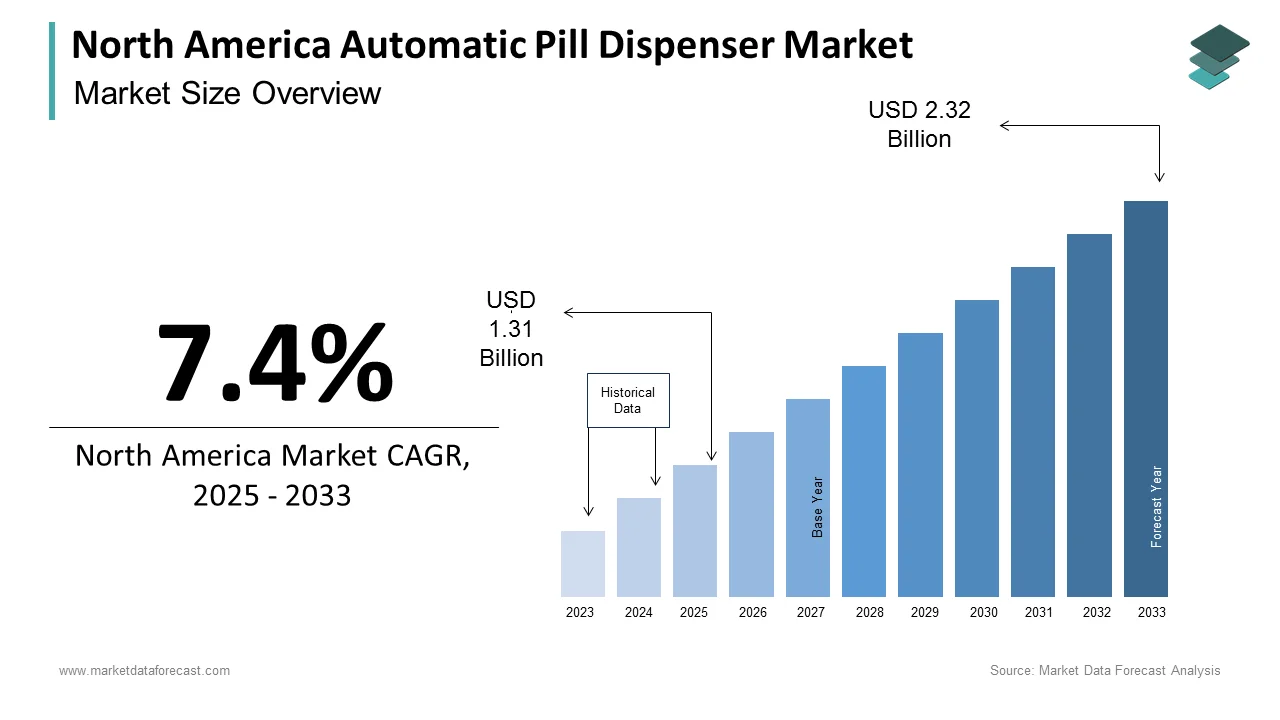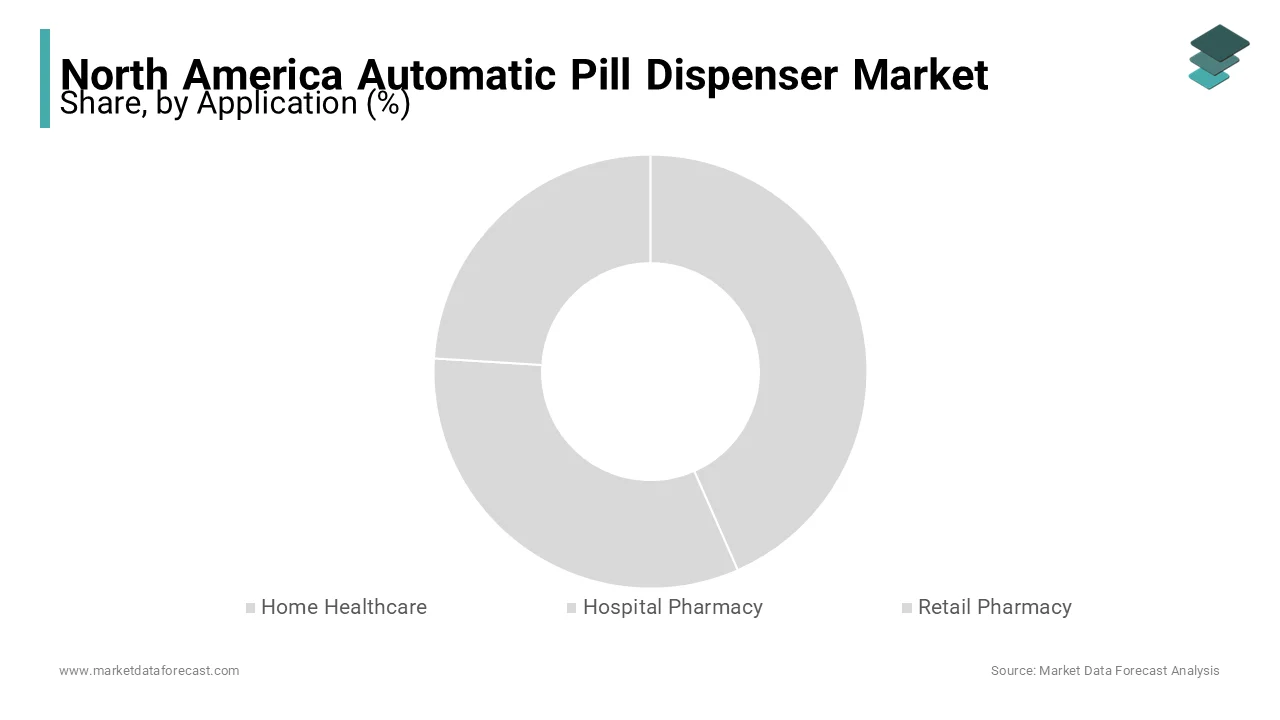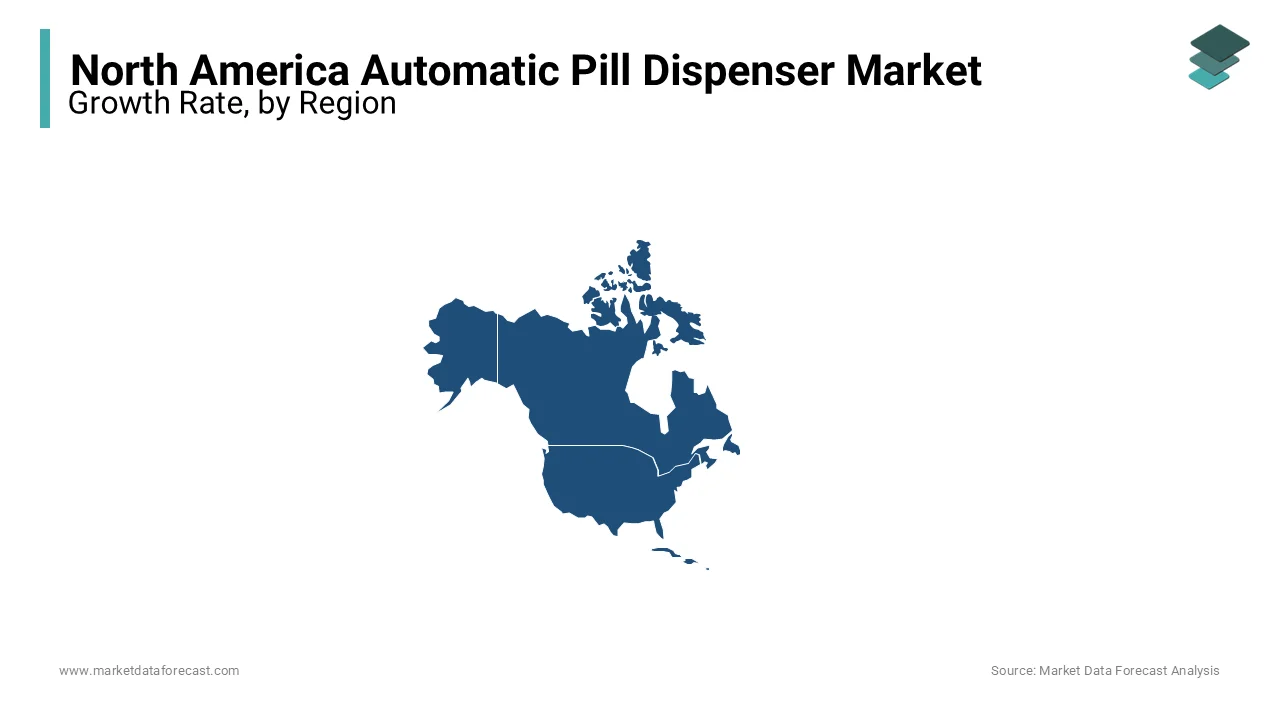North America Automatic Pill Dispenser Market Size, Share, Trends & Growth Forecast Report By Application, Type, Age Group, Indication & Country (the United States, Canada and Rest of North America) - Industry Analysis From 2025 to 2033.
North America Automatic Pill Dispenser Market Size
The Size of the automatic pill dispenser market in North America was valued at USD 1.22 billion in 2024. The North American market is expected to be valued at USD 1.31 billion in 2025 and USD 2.32 billion by 2033, exhibiting a CAGR of 7.4% from 2025 to 2033.
MARKET DRIVERS
Awareness Boosts Automatic Pill Dispenser Adoption
In the North American automatic pill dispenser market, growing awareness is a significant catalyst. This heightened awareness extends to both healthcare professionals and patients alike. Healthcare professionals, including doctors, pharmacists, and caregivers, are increasingly recognizing the pivotal role automatic pill dispensers play in enhancing patient outcomes. These professionals appreciate the device’s ability to improve medication, reduce the risk of dosage errors, and streamline the management of complex medication, resulting in better health outcomes and quality of life for their patients. However, patients are becoming more informed about the advantages of automatic pill dispensers. They see these devices as convenient solutions for managing their medications, especially when dealing with chronic conditions or age-related challenges. As awareness continues to rise, it is likely that the North America Automatic Pill Dispenser market will experience sustained growth, with more individuals recognizing the potential benefits of these devices for their health and well-being.
Technological Advancements Drive Pill Dispenser Market Growth
In the North America automatic pill dispenser market, technological advancements have been a driving force. Continuous innovation in this field has resulted in the development of highly user-friendly and dependable automatic pill dispensers, making them exceedingly attractive to consumers. Technological advancement is the integration of mobile apps, allowing users to manage their medication schedules conveniently from their smartphones or tablets. These apps often offer features like customizable dosing regimens, dosage history, and real-time medication reminders, enhancing user control and medication. Furthermore, remote monitoring capabilities have revolutionized medication management. Caregivers and healthcare providers can remotely track patients' pill consumption, receive alerts for missed doses, and even make adjustments to medication schedules when necessary, thereby improving patient care and peace of mind. Dose tracking features provide a comprehensive view of medication consumption, which is especially valuable for patients with complex medication regimens or those involved in clinical trials. As these technological advancements continue, the North America Automatic Pill Dispenser market is poised for sustained growth, offering consumers innovative and user-centric solutions for their medication management needs.
MARKET RESTRAINTS
High Initial and Ongoing Costs Limit Accessibility
The cost of automatic pill dispensers presents a significant restraint in the North America Automatic Pill Dispenser market. These devices often come with a price tag that includes the initial purchase cost and, in some cases, ongoing subscription fees for associated services. This financial burden can limit accessibility, particularly for patients without comprehensive health insurance coverage or those facing financial constraints. The issue of cost becomes even more critical in a region where healthcare expenses are a significant concern. Patients who do not have insurance plans covering automatic pill dispensers may be reluctant to invest in these devices despite their potential benefits in improving medication adherence and overall health outcomes.
REPORT COVERAGE
|
REPORT METRIC |
DETAILS |
|
Market Size Available |
2024 to 2033 |
|
Base Year |
2024 |
|
Forecast Period |
2025 to 2033 |
|
Segments Covered |
By Type, Application, Age, Indication, and Country. |
|
Various Analyses Covered |
Global, Regional & Country Level Analysis, Segment-Level Analysis; DROC, PESTLE Analysis, Porter's Five Forces Analysis, Competitive Landscape, Analyst Overview of Investment Opportunities |
|
Countries Covered |
United States, Canada, and the Rest of North America. |
|
Market Leader Profiled |
Swisslog Holdings AG, Dickinson and Company, McKesson Corporation, Becton, Cerner Corporation, Yuyama Co., Ltd, Baxter International Inc., Omnicell Inc., Illinois Tool Works Allscripts Healthcare Solutions, Inc., Capsa Healthcare, ScriptPro LLC, Meditech, Talyst, Inc., Accu-Chart Plus Healthcare System, Optum Inc., Pearson Medical Technologies and Constellation Software Inc., and Others. |
SEGMENTAL ANALYSIS
North America Automated Pill Dispenser Market Analysis By Type
- Carousels
- Centralized Automated Dispensing System
- Robots/Robotic Automated Dispensing System
- Ward-Based
- Decentralized Automated Dispensing
- Automated Unit Dose
- Pharmacy-Based
North America Automated Pill Dispenser Market Analysis By Application
- Home Healthcare
- Hospital Pharmacy
- Retail Pharmacy
North America Automated Pill Dispenser Analysis Market By Age
- 38-64 years
- 65-74 years
- 75-84 years
- 85 years and above
North America Automated Pill Dispenser Analysis By Indication
- Visual Impairment
- Old Age
- Dementia
- Learning Dementia
- Physical Disability
- Mental Health excluding dementia
- Parkinson’s disease
- Other Diseases
GEOGRAPHICAL ANALYSIS
- US
- Canada
North America is dominant due to the region's well-established healthcare infrastructure, a large aging population with chronic conditions, and a strong focus on technological innovation.
A rising healthcare infrastructure and a growing aging population characterize the US automatic pill dispenser market. The country's healthcare system, which often entails complex medication for seniors, has driven the adoption of automatic pill dispensers. Technological innovation and accessibility have contributed to the market's growth. The presence of health insurance coverage for certain automatic pill dispensers and a heightened awareness of medication adherence issues also bolsters their adoption.
In Canada, the automatic pill dispenser market is also showing notable growth. The country's healthcare system, which provides universal healthcare, encourages accessibility to healthcare services, including medication management solutions. Seniors often require assistance in managing their medications. Technological advancements and the integration of mobile apps have made automatic pill dispensers more appealing to consumers.
KEY MARKET PLAYERS
Companies playing a pivotal role in the North American automatic pill dispenser market profiled in this report are Swisslog Holdings AG, Dickinson and Company, McKesson Corporation, Becton, Cerner Corporation, Yuyama Co., Ltd, Baxter International Inc., Omnicell Inc., Illinois Tool Works Allscripts Healthcare Solutions, Inc., Capsa Healthcare, ScriptPro LLC, Meditech, Talyst, Inc., Accu-Chart Plus Healthcare System, Optum Inc., Pearson Medical Technologies and Constellation Software Inc.
Related Reports
Access the study in MULTIPLE FORMATS
Purchase options starting from
$ 2000
Didn’t find what you’re looking for?
TALK TO OUR ANALYST TEAM
Need something within your budget?
NO WORRIES! WE GOT YOU COVERED!
Call us on: +1 888 702 9696 (U.S Toll Free)
Write to us: sales@marketdataforecast.com



